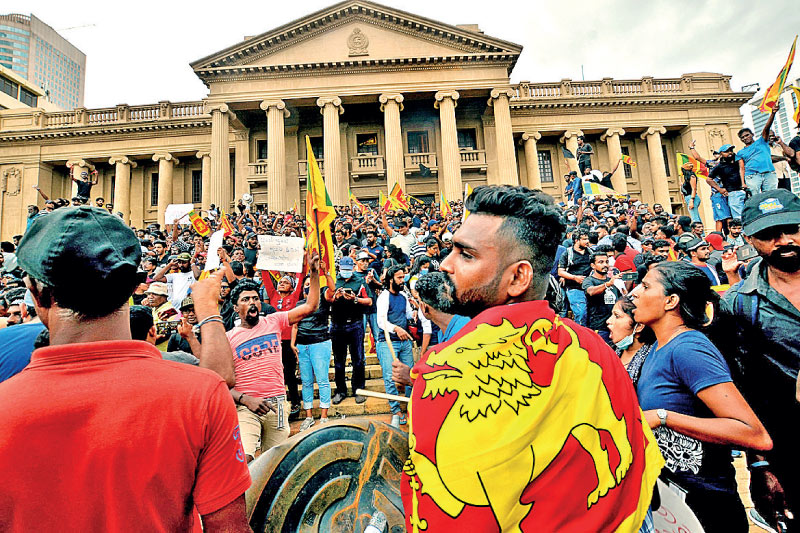Thursday Jan 15, 2026
Thursday Jan 15, 2026
Friday, 15 July 2022 00:29 - - {{hitsCtrl.values.hits}}

They are on the uncertain yet possible path to winning a new independence. The question now is whether we can provide the theoretical justification of its potential consequences to support a much broader transformation of society – Pic by Shehan Gunasekara
 Sri Lanka is experiencing a political opening. The people have participated in a momentous uprising against the regime of Gotabaya Rajapaksa that will likely set the tone of debate for decades to come. But the country is still mired in an economic depression. People remain desperate. It is in this uncertain moment that there are many possible scenarios.
Sri Lanka is experiencing a political opening. The people have participated in a momentous uprising against the regime of Gotabaya Rajapaksa that will likely set the tone of debate for decades to come. But the country is still mired in an economic depression. People remain desperate. It is in this uncertain moment that there are many possible scenarios.
The existing Parliament is experiencing a crisis of legitimacy. There is also the possibility of expanding the scope for representation through a People’s Council. Many are uncertain about what this moment means for reconstructing the foundation of Sri Lankan democracy. Is the possibility of a People’s Council, for example, mere justification for rabble rousers to destabilise the system? Or does it represent the possibility of resetting the boundary between state and society, to make it more representative, so that the people’s voice will be heard far more clearly?
The debate further hinges on the fact that there is, in turn, no clear, organised representative of the massive and diverse protest movement. Just like there is manoeuvring in Parliament, so are people wary of those who claim to speak on behalf of the movement. But our focus should prioritise the deeper question about what it means for the people to erupt with tremendous force onto the stage of history. Cultivating this historical sense is the first step to creating a self-aware core within the movement that can push it forward.
If there is work to be done, then, it must start not only from organising but also from comprehending this moment as a historical process. That means grasping the constellation of forces that have been revealed in the uprising, insofar as they can be understood as an expression of working people’s politics. To engage this question of the class bloc implicitly represented by the protest movement, it helps to return to a previous interpretation of another pivotal moment in Sri Lanka’s history.
The direction of history
The veteran theorist of the Lanka Sama Samaja Party (LSSP), Hector Abhayavardhana, argued that 1956 represented Sri Lanka’s “belated national liberation.” The Sri Lanka Freedom Party (SLFP) defeated the United National Party (UNP) regime and supposedly set the country on the path to a new model of development through import substitution. We now know, however, that the story was not as straightforward. In his own time, Abhayavardhana had a nuanced perspective. In his article published in 1975, “Stages in Our National Liberation,” he referred to the fact that “with all the hesitancy and circumspection, and even politicking, enough damage was done to the structure of imperialism-capitalism in Sri Lanka” through the SLFP’s victory.
But even he had a relatively linear interpretation of history. In his mind, the country first needed to accumulate capital through a national-oriented bourgeoisie, to create the material conditions in which a socialist force like the LSSP could take power. Abhayavardhana took the Marxist point about the fact that capitalism develops the forces of production up to a breaking point, to justify, in effect, alliance with the SLFP despite its Sinhala nationalist tendencies. He viewed the SLFP in terms of historical progress writ large.
Instead, Sri Lanka experienced greater ethnic divisions over the longer period, and the socialist project itself came under internal and external pressures. The Sinhala and Tamil nationalist movements that eventually eclipsed the left and became locked into mortal conflict transformed the country. The Rajapaksas, including Gotabaya and Mahinda, represented the culmination of this trend, pursuing military victory at tremendous human cost. But the Rajapaksas also formed a series of Bonapartist governments that had paradoxical consequences for their own grip on power.
Marx famously used the concept of Bonapartism to describe the authoritarian reign of Louis Bonaparte in 19th century France. That government ended up creating the terrain on which progressive democratic forces could organise and direct their anger toward the regime. In Marx’s case, that eventually meant the Paris Commune of 1871. In a parallel way, by representing themselves as the apex of the polity, the Rajapaksas made it all the easier for them to be dethroned. The statue of their forebear, D.A. Rajapaksa, was torn down earlier this year in Tangalle; much, as Marx might remind us, would happen to Louis Bonaparte when, in a figurative sense, the statue of his uncle, Napoleon, would come crashing down from “the top of the Vendôme Column.”
Some may understandably be sceptical of the actual progressive tendencies within the polity, despite the provisional setbacks that the Sinhala Buddhist nationalist project has experienced because of the de-legitimisation of the Rajapaksas. But if we are attuned to the deeper movement of history, we cannot ignore the potential consequences of the protest movement for bringing the periphery into view with renewed force. As Hegel put it, the goal must be to render “the unconscious impulse a conscious one.” Unlike Abhayavardhana, however, we can no longer assume that history proceeds in a relatively linear direction. Instead, we can now see that it is when working people and the broader masses come out to protest, that real change happens.
The country is in a state of economic collapse. But it is the demands and priorities of the people that provide the provisional outline of what political and economic changes must occur. These do not represent the motivation to accumulate capital for abstract ends, whether a particular vision of state socialism then, or the supposedly inevitable progress of free market globalisation today.
Democratic aspirations
The uprising on 9 July then need not be limited to bourgeois democratic advance. Instead, it can represent a rejection of the teleology inherent in our political understanding, the one that assumes society must reflect the intentional designs of a ruling class. Clearly that class has already failed in Sri Lanka, given the scale of the depression. The challenge is not to look elsewhere for solutions, but to ask whether there is an opportunity for the people’s demands to provide the outline for what society could become.
The sheer sense of possibility that emerges when watching people occupy the centres of power, including the Presidential Palace, is tangible. But it must be extended further to consider a much broader transformation of Sri Lanka as a polity. While many are suffering now on overcrowded public transport, making their way through the silent corridors of Colombo’s luxury high rise real estate developments, imagine what it would mean to reconstruct the very built environment in a way that improves people’s collective lives.
In contrast to the sceptics of the Aragalaya, then, it is crucial to draw out the uprising’s deeper meaning in a historical sense, rather than to try and cram it into a narrow interpretation of the Constitution. Clearly, the people of Sri Lanka have shown that they can control their own destiny. They are on the uncertain yet possible path to winning a new independence. The question now is whether we can provide the theoretical justification of its potential consequences to support a much broader transformation of society.
Moreover, we can consider the possibility that by reckoning with its own rulers, the people have also shown the way to a revived understanding of international solidarity that does not solely involve high-level negotiations between states. Instead, it means recognising the democratic aspirations of the people, including restructuring the State and transforming the economy to cope with the incredible hardships they are now facing. The onus is on the global institutions such as the IMF that claim to offer solutions to reckon with this example and for the hegemonic powers to heed demands to transform an unequal system. Meanwhile, in Sri Lanka, the people have begun this process by confronting their own rulers first.